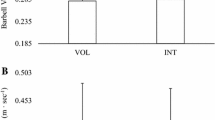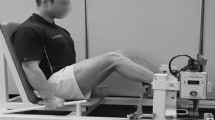Abstract
Volume load (VL) is suggested to influence the adaptation of muscle to resistance exercise (RE). We sought to examine the independent association between total VL and hypertrophy and strength following a progressive RE protocol of equated sets and intensity. Total VL was calculated in 83 subjects (n = 43 males, n = 40 females; age = 25.12 ± 5.5 years) who participated in unilateral arm RE for 12 weeks. Subjects were tested for biceps muscle volume (MRI of the upper arm), isometric maximal voluntary contraction (MVC), and dynamic biceps strength (1RM), at baseline and following RE. Linear regression analysis revealed that sex was a significant predictor of hypertrophy (β = 0.06; p = 0.01) and strength (β = 0.14; p = 0.04), and that males had greater increases. Total VL was independently associated with hypertrophy only among females (β = 0.12; p < 0.01). For males, only baseline strength was (inversely) related to hypertrophy (β = −0.12; p = 0.04). VL was strongly associated with changes in 1RM strength improvement for both males (β = 0.66; p < 0.01) and females (β = 0.26; p = 0.02), but only related to MVC among females (β = 0.20; p = 0.02). Findings reveal that VL was independently associated with hypertrophy only among females. For males baseline strength was independently and inversely related to changes in muscle mass. Conversely, VL was found to be strongly associated with changes in 1RM for both males and females, controlling for age, body mass, and baseline strength.
Similar content being viewed by others
References
Aagaard P, Andersen JL, Dyhre-Poulsen P, Leffers AM, Wagner A, Magnusson SP, Halkjaer-Kristensen J, Simonsen EB (2001) A mechanism for increased contractile strength of human pennate muscle in response to strength training: changes in muscle architecture. J Physiol 534:613–623
Aagaard P, Simonsen EB, Andersen JL, Magnusson P, Dyhre-Poulsen P (2002) Increased rate of force development and neural drive of human skeletal muscle following resistance training. J Appl Physiol 93:1318–1326
ACSM (2009) American College of Sports Medicine position stand. Progression models in resistance training for healthy adults. Med Sci Sports Exerc 41:687–708
Baechle T, Earle R, Wathen D (2008) Resistance Training. In: Baechle T, Earle R (eds) Essentials of strength training and conditioning. Human Kinetics, Champaign, pp 381–412
Campos GE, Luecke TJ, Wendeln HK, Toma K, Hagerman FC, Murray TF, Ragg KE, Ratamess NA, Kraemer WJ, Staron RS (2002) Muscular adaptations in response to three different resistance-training regimens: specificity of repetition maximum training zones. Eur J Appl Physiol 88:50–60
Haff GG, Jackson JR, Kawamori N, Carlock JM, Hartman MJ, Kilgore JL, Morris RT, Ramsey MW, Sands WA, Stone MH (2008) Force–time curve characteristics and hormonal alterations during an eleven-week training period in elite women weightlifters. J Strength Cond Res 22:433–446
Holm L, Reitelseder S, Pedersen TG, Doessing S, Petersen SG, Flyvbjerg A, Andersen JL, Aagaard P, Kjaer M (2008) Changes in muscle size and MHC composition in response to resistance exercise with heavy and light loading intensity. J Appl Physiol 105:1454–1461
Hubal MJ, Gordish-Dressman H, Thompson PD, Price TB, Hoffman EP, Angelopoulos TJ, Gordon PM, Moyna NM, Pescatello LS, Visich PS, Zoeller RF, Seip RL, Clarkson PM (2005) Variability in muscle size and strength gain after unilateral resistance training. Med Sci Sports Exerc 37:964–972
Kang J, Hoffman JR, Im J, Spiering BA, Ratamess NA, Rundell KW, Nioka S, Cooper J, Chance B (2005) Evaluation of physiological responses during recovery following three resistance exercise programs. J Strength Cond Res 19:305–309
Kok LY, Hamer PW, Bishop DJ (2009) Enhancing muscular qualities in untrained women: linear versus undulating periodization. Med Sci Sports Exerc 41:1797–1807
Kraemer WJ, Ratamess NA (2005) Hormonal responses and adaptations to resistance exercise and training. Sports Med 35:339–361
Kraemer WJ, Gordon SE, Fleck SJ, Marchitelli LJ, Mello R, Dziados JE, Friedl K, Harman E, Maresh C, Fry AC (1991) Endogenous anabolic hormonal and growth factor responses to heavy resistance exercise in males and females. Int J Sports Med 12:228–235
Kraemer WJ, Ratamess N, Fry AC, Triplett-McBride T, Koziris LP, Bauer JA, Lynch JM, Fleck SJ (2000) Influence of resistance training volume and periodization on physiological and performance adaptations in collegiate women tennis players. Am J Sports Med 28:626–633
Kraemer WJ, Nindl BC, Ratamess NA, Gotshalk LA, Volek JS, Fleck SJ, Newton RU, Hakkinen K (2004) Changes in muscle hypertrophy in women with periodized resistance training. Med Sci Sports Exerc 36:697–708
Luebbers PE, Potteiger JA, Warren BJ, Clore JN, Jennings C, Bond DS (2008) Glucose uptake after resistance training of different intensities but of equal work volume. J Strength Cond Res 22:1094–1100
Marx JO, Ratamess NA, Nindl BC, Gotshalk LA, Volek JS, Dohi K, Bush JA, Gomez AL, Mazzetti SA, Fleck SJ, Hakkinen K, Newton RU, Kraemer WJ (2001) Low-volume circuit versus high-volume periodized resistance training in women. Med Sci Sports Exerc 33:635–643
Marzolini S, Oh PI, Thomas SG, Goodman JM (2008) Aerobic and resistance training in coronary disease: single versus multiple sets. Med Sci Sports Exerc 40:1557–1564
Mazzetti S, Douglass M, Yocum A, Harber M (2007) Effect of explosive versus slow contractions and exercise intensity on energy expenditure. Med Sci Sports Exerc 39:1291–1301
McBride JM, Blaak JB, Triplett-McBride T (2003) Effect of resistance exercise volume and complexity on EMG, strength, and regional body composition. Eur J Appl Physiol 90:626–632
McBride JM, McCaulley GO, Cormie P, Nuzzo JL, Cavill MJ, Triplett NT (2009) Comparison of methods to quantify volume during resistance exercise. J Strength Cond Res 23:106–110
McCall GE, Byrnes WC, Dickinson A, Pattany PM, Fleck SJ (1996) Muscle fiber hypertrophy, hyperplasia, and capillary density in college men after resistance training. J Appl Physiol 81:2004–2012
Moritani T, de Vries HA (1979) Neural factors versus hypertrophy in the time course of muscle strength gain. Am J Phys Med 58:115–130
Ronnestad BR, Egeland W, Kvamme NH, Refsnes PE, Kadi F, Raastad T (2007) Dissimilar effects of one- and three-set strength training on strength and muscle mass gains in upper and lower body in untrained subjects. J Strength Cond Res 21:157–163
Seynnes OR, de Boer M, Narici MV (2007) Early skeletal muscle hypertrophy and architectural changes in response to high-intensity resistance training. J Appl Physiol 102:368–373
Starkey DB, Pollock ML, Ishida Y, Welsch MA, Brechue WF, Graves JE, Feigenbaum MS (1996) Effect of resistance training volume on strength and muscle thickness. Med Sci Sports Exerc 28:1311–1320
Thompson PD, Moyna N, Seip R, Price T, Clarkson P, Angelopoulos T, Gordon P, Pescatello L, Visich P, Zoeller R, Devaney JM, Gordish H, Bilbie S, Hoffman EP (2004) Functional polymorphisms associated with human muscle size and strength. Med Sci Sports Exerc 36:1132–1139
Tran QT, Docherty D, Behm D (2006) The effects of varying time under tension and volume load on acute neuromuscular responses. Eur J Appl Physiol 98:402–410
Twisk J, Proper K (2004) Evaluation of the results of a randomized controlled trial: how to define changes between baseline and follow-up. J Clin Epidemiol 57:223–228
Yarasheski KE (2003) Exercise, aging, and muscle protein metabolism. J Gerontol A Biol Sci Med Sci 58:M918–M922
Yarasheski KE, Zachwieja JJ, Bier DM (1993) Acute effects of resistance exercise on muscle protein synthesis rate in young and elderly men and women. Am J Physiol 265:E210–E214
Young A, Stokes M, Round JM, Edwards RH (1983) The effect of high-resistance training on the strength and cross-sectional area of the human quadriceps. Eur J Clin Invest 13:411–417
Acknowledgments
We acknowledge Ms. Pheobe Stapleton and Mr. Mathew Kampert for their assistance with this investigation. This research was supported by the NIH, NICHD, NCMRR Grant #5-T32-HD007422. No financial disclosures were reported by the authors of this paper. The results of the present study do not constitute endorsement by ACSM.
Author information
Authors and Affiliations
Corresponding author
Additional information
Communicated by William Kraemer.
Electronic supplementary material
Below is the link to the electronic supplementary material.
421_2010_1735_MOESM1_ESM.doc
Percent change in muscle hypertrophy among males stratified by median baseline strength capacity, into low (n = 17) and high (n = 19) strength groups (DOC 26 kb)
Rights and permissions
About this article
Cite this article
Peterson, M.D., Pistilli, E., Haff, G.G. et al. Progression of volume load and muscular adaptation during resistance exercise. Eur J Appl Physiol 111, 1063–1071 (2011). https://doi.org/10.1007/s00421-010-1735-9
Accepted:
Published:
Issue Date:
DOI: https://doi.org/10.1007/s00421-010-1735-9




